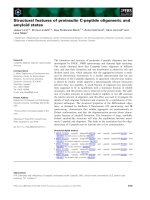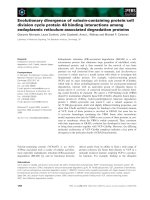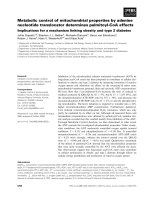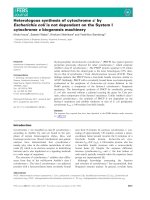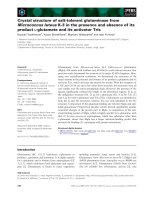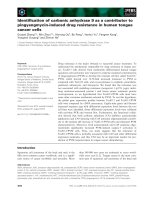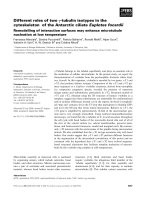Báo cáo khoa học: Heterologous synthesis of cytochrome c¢ by Escherichia coli is not dependent on the System I cytochrome c biogenesis machinery ppt
Bạn đang xem bản rút gọn của tài liệu. Xem và tải ngay bản đầy đủ của tài liệu tại đây (250.88 KB, 8 trang )
Heterologous synthesis of cytochrome c¢ by
Escherichia coli is not dependent on the System I
cytochrome c biogenesis machinery
Hiroki Inoue
1
, Satoshi Wakai
1
, Hirofumi Nishihara
2
and Yoshihiro Sambongi
1
1 Graduate School of Biosphere Science, Hiroshima University, Japan
2 Faculty of Agriculture, Ibaraki University, Japan
Introduction
Cytochromes c¢ are classified as class II cytochromes c
according to Ambler [1], and are found in the peri-
plasm of certain Gram-negative Alpha-, Beta- and
Gammaproteobacteria. Recent biochemical and genetic
analyses have demonstrated that cytochromes c¢
mainly play roles in the cellular metabolism of nitric
oxide [2], which is an electron acceptor in denitrifying
bacteria and is also implicated as a signaling molecule
in a wide range of organisms.
The structure of cytochromes c¢ exhibits clear differ-
ences from that of the well-known Ambler’s class I
cytochromes c. The class I cytochromes c are spherical
proteins with a hexacoordinate heme covalently bound
near their N-termini. In contrast, cytochromes c¢, con-
sisting of approximately 130 residues, contain a penta-
coordinate heme located towards the C-terminus of a
four-helix bundle protein. Escherichia coli cyto-
chrome b
562
(EC b
562
), a 106-residue protein, also has
a four-helix bundle structure with a noncovalently
bound heme [3]. Despite the sequence difference
between cytochromes b
562
and c¢, the four helices of
each nearly spatially coincide when the respective heme
groups are superimposed [4].
Although knowledge concerning the function
and structure of cytochromes c¢ has accumulated, their
biogenesis remains unclear. In general, covalent heme
Keywords
cytochrome c biogenesis; cytochrome c¢;
Escherichia coli; heterologous synthesis;
System I
Correspondence
Y. Sambongi, Graduate School of Biosphere
Science, Hiroshima University, 1-4-4
Kagamiyama, Higashi-Hiroshima, Hiroshima
739-8528, Japan
Fax: +81 824 24 7924
Tel: +81 824 24 7924
E-mail:
(Received 28 February 2011, revised 5 April
2011, accepted 27 April 2011)
doi:10.1111/j.1742-4658.2011.08155.x
Hydrogenophilus thermoluteolus cytochrome c¢ (PHCP) has typical spectral
properties previously observed for other cytochromes c¢, which comprise
Ambler’s class II cytochromes c. The PHCP protein sequence (135 amino
acids) deduced from the cloned gene is the most homologous (55% iden-
tity) to that of cytochrome c¢ from Allochromatium vinosum (AVCP). These
findings indicate that PHCP forms a four-helix bundle structure, similar to
AVCP. Strikingly, PHCP with a covalently bound heme was heterologously
synthesized in the periplasm of Escherichia coli strains deficient in the
DsbD protein, a component of the System I cytochrome c biogenesis
machinery. The heterologous synthesis of PHCP by aerobically growing
E. coli also occurred without a plasmid carrying the genes for Ccm pro-
teins, other components of the System I machinery. Unlike Ambler’s class I
general cytochromes c, the synthesis of PHCP is not dependent on the
System I machinery and exhibits similarity to that of E. coli periplasmic
cytochrome b
562
, a 106-residue four-helix bundle.
Database
The sequence data reported here have been deposited in the DDBJ database under accession
no.
AB617519.
Abbreviations
AVCP, Allochromatium vinosum cytochrome c¢; Ccm, cytochrome c maturation; Dsb, disulfide bond formation; EC b
562
, Escherichia coli
cytochrome b
562
; PHCP, Hydrogenophilus thermoluteolus cytochrome c¢;PHc
552
, Hydrogenophilus thermoluteolus cytochrome c
552
.
FEBS Journal 278 (2011) 2341–2348 ª 2011 The Authors Journal compilation ª 2011 FEBS 2341
attachment to class I cytochromes c is catalyzed by the
cellular machinery, resulting in cytochrome c biogene-
sis [5]. For example, in some Gram-negative bacteria,
such as E. coli, the System I cytochrome c biogenesis
machinery, consisting of some disulfide bond forma-
tion (Dsb) and cytochrome c maturation (Ccm)
proteins, is responsible for the biogenesis of a wide
variety of both endogenous and exogenous class I cy-
tochromes c [6]. Successful heterologous synthesis of
several cytochromes c¢ has been reported using aerobi-
cally growing E. coli with co-expressed ccm genes from
a plasmid [7–9]. However, a variant of EC b
562
, which
has been mutated so as to bind heme covalently like
cytochromes c, can be formed as a holo-protein with-
out co-expressed ccm genes from a plasmid [10,11].
Although the heme-binding mode of the resulting
EC b
562
variant differs from that with co-expressed
ccm genes from a plasmid, its holo-formation is obvi-
ous. This prompted us to re-examine the heterologous
synthesis of cytochromes c¢ with or without co-
expressed ccm genes from a plasmid. In addition, the
effects of Dsb proteins on cytochrome c¢ synthesis
have not been examined to date.
In this study, we examined the heterologous synthesis
of cytochrome c¢ proteins by E. coli strains deficient in
the DsbD protein and co-expressing or not co-express-
ing ccm genes from a plasmid. For this purpose, we first
purified and characterized Hydrogenophilus thermoluteo-
lus cytochrome c¢ (PHCP). Secondly, the PHCP gene
was cloned for sequence and expression analyses. Heter-
ologous synthesis of the PHCP protein by the E. coli
strains was investigated in direct comparison with that
of H. thermoluteolus cytochrome c
552
(PH c
552
), which
is a typical class I cytochrome c that has been demon-
strated to be System I dependent with regard to its bio-
genesis in E. coli [12,13]. Our results provide
information on the biogenesis of cytochromes c¢, which
has not been studied systematically.
Results
Purification of the PHCP protein
The PHCP protein was purified to homogeneity by col-
umn chromatography, as illustrated on an SDS ⁄ PAGE
gel (Fig. 1). The estimated molecular weight of the
PHCP protein on the gel was 13 kDa, which was close
to that of other cytochromes c¢ isolated from various
bacteria. The N-terminal amino acid sequence of
PHCP was determined up to the 30th residue, as illus-
trated in Fig.2.Ablast search indicated that the pro-
tein sequence determined up to the 30th residue was
homologous to that of other cytochromes c¢ isolated
from other bacteria. Thus, at this stage of the present
work, we concluded that the purified PHCP protein
was a novel cytochrome c¢ isolated from H. thermolute-
olus.
Spectral properties of the authentic PHCP protein
Visible absorption spectra of the authentic PHCP pro-
tein purified from H. thermoluteolus were obtained to
examine the local heme environment in the protein
interior. The spectra of the oxidized and reduced
PHCP were essentially the same as those reported for
other cytochromes c¢ (Fig. 3A), indicating that the
heme environment in the PHCP protein was similar to
that in others. Specifically, a Soret band at 425 nm
was observed for the reduced form of PHCP, which is
characteristic of a pentacoordinate heme with a His
residue as an axial ligand [14]. Furthermore, a peak
around 630 nm was observed for the oxidized form of
PHCP, indicating that the position of the sixth ligand
to the heme iron is empty, as discussed for other cyto-
chromes c¢ [14]. In addition, the a-band in the pyridine
hemochrome spectrum of reduced PHCP corresponded
to 550 nm, which is indicative of the covalent bonding
of heme vinyl groups to the protein via two thioether
linkages.
A far-UV CD spectrum (190–260 nm) was obtained
to examine the secondary structure of the PHCP
Mw (kDa)
1 2 3 4
75
25
20
15
10
5
5
Fig. 1. Purification of the Hydrogenophilus thermoluteolus cyto-
chrome c¢ (PHCP) protein. Lane 1, total soluble extract of H. therm-
oluteolus cells; lane 2, HiTrap Q batch elution with 0.2
M NaCl; lane
3, HiTrap Q linear gradient elution with 0–0.2
M NaCl; lane 4,
HiTrap SP flow-through elution; lane 5, Sephadex 75 elution. The
arrow indicates the position of PHCP. One to ten micrograms of
protein were loaded per lane, and the gel was stained with Coo-
massie Brilliant Blue.
Biogenesis of cytochrome c¢ H. Inoue et al.
2342 FEBS Journal 278 (2011) 2341–2348 ª 2011 The Authors Journal compilation ª 2011 FEBS
protein. From the ellipticity peak height of the PHCP
protein at 222 nm (Fig. 3B), its helical content was cal-
culated to be 60.3% [15]. This value is close to the
a-helical content of Allochromatium vinosum cyto-
chrome c¢ (AVCP), i.e. 63.0%, which was calculated
directly from its primary (Fig. 2) and three-dimen-
sional [16] structures.
Cloning of the PHCP gene
PCR with mixed primers PHcp01fw and PHcp01rv,
using H. thermoluteolus chromosomal DNA as a tem-
plate, gave a DNA fragment of approximately 360 bp,
which was then cloned into the pUC19 vector. At least
five independent clones were sequenced, and the amino
acid sequence (25th to 125th residues, Fig. 2) deduced
from the DNA was homologous to the sequences of
cytochromes c¢ deposited previously in the database.
Using the inverse PCR method, we obtained a single
6.5-kbp DNA fragment from an SphI-digested
H. thermoluteolus chromosomal DNA library. DNA
sequencing of the fragment revealed that the product
contained the 5¢ and 3¢ ends of the PHCP gene plus
putative promoter, Shine–Dalgarno and transcriptional
terminator sequences. From the deduced sequence, the
mature PHCP was found to consist of 135 amino
acids, and the N-terminal Asp was preceded by a Sec-
dependent periplasmic targeting signal peptide of 19
amino acid residues (Fig. 2). This indicates that the
PHCP protein is synthesized as a precursor, and that
its signal peptide is cleaved off during translocation to
the periplasm of H. thermoluteolus cells.
From the amino acid sequence deduced from the
cloned PHCP gene, the heme-binding motif observed
in general cytochromes c, Cys–X–X–Cys–His, was
found to be located close to the C-terminus of the
PHCP protein, which is conserved in other biochemi-
cally characterized cytochromes c¢ (Fig. 2). The mature
PHCP protein exhibited overall sequence identity of
54.8% to AVCP, this being the highest identity among
the homologs in the genome database.
Heterologous synthesis of the PHCP and PH c
552
proteins by E. coli
The cloned PHCP gene, together with the typical
class I PH c
552
gene as a reference control, was exam-
ined with regard to its heterologous expression in
various E. coli strains by means of heme-specific stain-
ing of SDS ⁄ PAGE gels. On such gels, when stained
materials are observed at positions coinciding with
those of PHCP and PH c
552
, the proteins each have a
covalently attached heme, which is defined here as
completion of cytochrome c synthesis.
The PHCP protein was heterologously synthesized
in the periplasm of anaerobically growing E. coli dsbD
20 30 40 50 60 70
80 90 100 110 120 130
1 10
mkriamitaltlcaaaahaDALKPEDKVKFRQAS
mkhvlastaaglmalgl-assaiaAGLSPEEQIETRQAG
mkklstlaalacmtvgsll-atsaqaQFAKPEDAVKYRQSA
mrrvllatlmaalpaaaMAADAEHVVEARKGY
(1) H. thermoluteolus
(2) A. vinosum
(3) A. xylosoxidans
(4) R. sphaeroides
YTTMAWNMGKIKAMVVDGTMPFSQTQVSAAANVIAAIANSGMGALYSPDTLGVVGFKKSR
YEFMGWNMGKIKA-NLEGE YNAAQVEAAANVIAAIANSGMGALYGPGTDKNVGDVKTR
LTLMASHFGRMTP-VVKGQAPYDAAQIKANVEVLKTLSAL-PWAAFGPGTEGG-D
FSLVALEFGPLAAM-AKGEMPYDAAAAKAHASDLVTLTKYDPSDLYAPGTSAD-DVKGTA
LKENFFQEQDEVRKIATNFVEQANKLAEVAAMGDKDEIKAQFGEVGKACKACHEKFREEE
VKPEFFQNMEDVGKIAREFVGAANTLAEVAATGEAEAVKTAFGDVGAACKSCHEKYRAK-
ARPEIWSDAASFKQKQQAFQDNIVKLSAAADAGDLDKLRAAFGDVGASCKACHDAYRKKK
AKAAIWQDADGFQAKGMAFFEAVAALEPAAGAGQKE-LAAAVGKVGGTCKSCHDDFRVKR
* ** * *
* * * *
Fig. 2. Multiple sequence analysis of biochemically characterized cytochrome c¢ proteins. Experimentally determined signal peptides are
depicted in lower case letters. The numbering on the Hydrogenophilus thermoluteolus cytochrome c¢ (PHCP) sequence is that of the mature
protein. The sequence of PHCP was chemically determined up to the 30th residue in this study and confirmed by the protein sequence
deduced from the cloned gene. The stretches of the PHCP amino acid sequence used for the design of the PCR primers are underlined with
arrows indicating the 5¢ to 3¢ direction. The sequences of biochemically characterized cytochromes c¢ were obtained from a database: (2)
locus tag of Alvin_2765 of Allochromatium vinosum DSM180; (3) accession number P00138 of Achromobacter xylosoxidans NCIMB11015;
(4) locus tag of RSP_0474 of Rhodobacter sphaeroides 2.4.1. The consensus cytochrome c Cys–X–X–Cys–His heme-binding motif is close to
the C-terminus of each protein. Gaps in the alignment are indicated by dashes. Identical residues to those in PHCP are highlighted in gray.
Helical regions determined from the crystal structure of A. vinosum cytochrome c¢ (AVCP) are underlined. A residue occupying the empty
sixth ligand to the heme iron and hydrophobic residues in contact with the heme in the AVCP structure are indicated by asterisks above the
sequence (see details in the Discussion section).
H. Inoue et al. Biogenesis of cytochrome c¢
FEBS Journal 278 (2011) 2341–2348 ª 2011 The Authors Journal compilation ª 2011 FEBS 2343
null mutant strain RI242, whereas the PH c
552
protein
was not (Fig. 4). The isogenic wild-type E. coli RI89
strain with the intact DsbD protein was able to heter-
ologously synthesize the PHCP and PH c
552
proteins,
confirming that the observed difference between
the two proteins in the RI242 strain is a result of the
absence of the DsbD protein.
PHCP was also synthesized as a holo-protein in the
periplasm of aerobically growing E. coli JCB387 cells
not harboring the pEC86 plasmid carrying the ccm
genes (Fig. 4). In contrast, when it did not harbor the
plasmid, the E. coli JCB387 strain was not able to
produce PH c
552
aerobically. These results indicate that
the present growth conditions in the absence of pEC86
do not confer the cytochrome c biogenesis ability to
the PH c
552
protein. This is possibly a result of the
shortage of Ccm proteins, because the expression of
ccm genes is repressed under aerobic growth condi-
tions.
In the presence of the pEC86 plasmid, both the
PHCP and PH c
552
proteins were heterologously syn-
thesized in the periplasm of E. coli JCB387 cells
(Fig. 4). Judging from the staining intensity, the level
of production of the PHCP protein in the presence of
the pEC86 plasmid was significantly lower than that
without the plasmid, indicating that the co-expression
of plasmid-borne ccm genes represses PHCP overpro-
duction by aerobically growing E. coli cells. A similar
difference in the PHCP production level was observed
in the early and late logarithmic and stationary phases
of E. coli JCB387 cells with and without the pEC86
plasmid.
Spectral properties of PHCP heterologously
synthesized by E. coli
The visible absorption spectra of periplasmic extracts
containing the PHCP protein heterologously synthe-
sized by E. coli RI242 and JCB387 without pEC86
were the same as those observed for the authentic
Wavelength (nm)
Oxidized PHCP
Reduced PHCP
Absorbance (A.U.)
300 400
425
630
500 600 700
0.0
0.1
0.2
0.3
0.4
0.5
0.6
200
220
240 260
–20
–10
0
10
20
30
40
[θ] × 10
–3
(deg·cm
2
·dmol
–1
)
Wavelength (nm)
222
B
A
Fig. 3. Spectral analysis of the authentic Hydrogenophilus thermo-
luteolus cytochrome c¢ (PHCP) protein: (A) visible absorption spec-
tra; (B) CD spectra. Specific wavelengths referred to in the text are
indicated by arrows in (A) and (B).
20
–pEC86
c' c'c
552
c
552
c' c
552
c' c
552
Mw (kDa)
RI242 JCB387
15
10
*
5
RI89
+pEC86
Fig. 4. Heterologous synthesis of cytochromes c by Escherichia
coli strains. Periplasmic extracts (equivalent to 5 · 10
8
cells) of the
E. coli RI242 and RI89 strains, and the JCB387 strain without (indi-
cated by –) or with (indicated by +) the pEC86 plasmid carrying the
ccm genes, were analyzed by heme staining after SDS ⁄ PAGE. In
each lane of the gel, periplasmic extracts from the E. coli cells
transformed with the Hydrogenophilus thermoluteolus cyto-
chrome c¢ (PHCP) and H. thermoluteolus cytochrome c
552
(PH c
552
)
genes are indicated as c¢ and c
552
, respectively. The arrow and
arrowhead indicate the positions of the PHCP and PH c
552
proteins,
respectively. The band denoted by the asterisk on the right-hand
side is the result of nonspecific staining of the extracts containing
the PH c
552
protein.
Biogenesis of cytochrome c¢ H. Inoue et al.
2344 FEBS Journal 278 (2011) 2341–2348 ª 2011 The Authors Journal compilation ª 2011 FEBS
purified protein in both the oxidized and reduced
states (Fig. 3A). These findings indicate that the heme
is correctly incorporated into the apo-form of PHCP
heterologously synthesized by E. coli, even without the
DsbD protein and without co-expression of the ccm
genes from the pEC86 plasmid. In addition, the
a-band in the pyridine hemochrome spectra of the
same periplasmic extracts with dithionite corresponded
to 550 nm, as observed for the authentic PHCP pro-
tein, indicating the covalent attachment of the heme to
the protein through two thioether bonds.
Discussion
In this study, we attempted to determine whether or
not Ambler’s class II cytochromes c¢ are synthesized
by the System I cytochrome c biogenesis machinery.
For this purpose, we first performed spectral analysis
of the authentic PHCP protein, aiming at the predic-
tion of its structure, which is the final state of biogene-
sis. Secondly, the PHCP gene was cloned to gain
sequence information and to examine its heterologous
expression in E. coli strains with reference to PH c
552
,
which has been characterized as a System I-dependent
cytochrome c.
Spectral properties of the authentic PHCP protein
The visible absorption and CD spectral features of the
PHCP protein indicate that its local heme environment
and helical content are similar to those found in typi-
cal cytochromes c¢. In the four-helix bundle structure
of general cytochromes c¢, access to the sixth ligand
position with regard to the heme iron is hindered
primarily by the side-chains of aromatic or nonaromat-
ic hydrophobic residues. Such a responsible residue is
Tyr16 in the crystal structure of the AVCP protein
[16]. The same residue is also conserved in the PHCP
protein (Fig. 2).
Other residues responsible for the maintenance of
the hydrophobic environment around the heme in
AVCP are Met19, Gly20, Met23, Tyr61, Val76,
Phe80, Val87, Val95 and Val120 (PHCP numbering,
Fig. 2), which directly face the heme group [16]. Of
these nine residues, seven are identical in PHCP, the
other two, Gly20 and Val76, in AVCP being homolo-
gously replaced by Ala20 and Leu76, respectively, in
PHCP. These sequence similarities, together with the
spectral properties observed for the PHCP and AVCP
proteins, indicate that the former has a three-dimen-
sional structure comprising a four-helix bundle, as
demonstrated for other cytochromes c¢, including the
latter.
Heterologous synthesis of PHCP by E. coli
The E. coli System I cytochrome c biogenesis machin-
ery, consisting of the Dsb and Ccm proteins, is respon-
sible for the synthesis of class I cytochromes c even
from various exogenous sources [6]. Normally, the
E. coli chromosomal ccm genes are not aerobically
expressed. Therefore, through co-expression of the ccm
genes in the pEC86 plasmid, together with various
class I cytochrome c genes, holo-cytochromes c can be
successfully overproduced by aerobically growing
E. coli cells. In previous studies, it has been shown that
co-expression of the ccm genes in the pEC86 plasmid
is required for the heterologous expression of class II
cytochromes c¢ by E. coli [7–9], predicting that cyto-
chrome c¢ biogenesis is System I dependent. However,
systematic studies on the effects of the ccm and dsb
genes with reference controls have not been performed.
It is clear from our results that the co-expression of
the ccm genes in the pEC86 plasmid and the presence
of the DsbD protein are not necessarily required for
the heterologous synthesis of the PHCP protein by
E. coli, unlike that of class I cytochromes c, including
the PH c
552
protein.
Similarity to and differences from periplasmic
EC b
562
Previously, the c-type heme-binding Cys–X–X–Cys–
His motif was introduced into periplasmic EC b
562
in
order to determine whether or not the resulting variant
is synthesized as a holo-protein with a covalently
bound heme [10]. Even without the DsbD protein or
without co-expression of the ccm genes in a plasmid,
the EC b
562
variant can be formed as a holo-protein
with a covalently bound heme [11]. Although the pro-
duction level and heme-binding mode of the EC b
562
variant under these conditions differ from those with
the dsbD gene product or with the co-expression of the
ccm genes in a plasmid, holo-protein synthesis clearly
occurs with such an imperfect System I cytochrome c
biogenesis machinery. Therefore, the EC b
562
variant
resembles the PHCP protein in terms of biogene-
sis, which is different from System I cytochrome c
biogenesis.
The above EC b
562
variant with the c-type heme-bind-
ing Cys–X–X–Cys–His motif was further modified so as
to add extra Cys residues around the motif. The result-
ing variants were examined for heterologous synthesis
by E. coli JCB387 with or without the pEC86 plasmid, it
being shown that co-expression of the ccm genes in the
plasmid caused enhanced levels of production of the
variants [17]. These observations are not consistent with
H. Inoue et al. Biogenesis of cytochrome c¢
FEBS Journal 278 (2011) 2341–2348 ª 2011 The Authors Journal compilation ª 2011 FEBS 2345
those in the present study, in which the co-expression of
the ccm genes in the pEC86 plasmid was found to result
in a low level of production of PHCP (Fig. 4). There is
presently no explanation as to why the production levels
differ between the PHCP protein and the EC b
562
variant. Further experiments on the two proteins with
the same growth medium and aerobicity are required for
a clear comparison, which will provide information on
the function of Ccm proteins.
Structural implication for PHCP synthesis
Although the sequence identity is low between the
PHCP protein and the EC b
562
variant, they may have
the same architecture, comprising a four-helix bundle
structure, indicating that their folding mechanisms,
including heme attachment, are conserved, as sug-
gested previously [18]. A large portion of the EC b
562
protein can fold in the absence of heme to yield its
apo-form with an empty heme-binding site [19]. Should
such a folding process in apo-EC b
562
also occur in
apo-PHCP, the latter protein may incorporate free
heme, which is then spontaneously bound in a
System I-independent manner. Although no direct evi-
dence for this is available, hydrophobic interactions
within apo-PHCP may facilitate protein folding in the
absence of heme, as observed for Aquifex aeolicus
class I cytochrome c
555
, whose apo-form is exception-
ally folded [20,21]. It would be of interest to investi-
gate further the biogenesis mechanism for PHCP with
regard to the relation to its structural features in
conjunction with a mutagenesis study.
Materials and methods
Purification of PHCP from H. thermoluteolus
Hydrogenophilus thermoluteolus TH-1 [22] was cultured at
45 °C in an inorganic medium under H
2
:O
2
:CO
2
(75 : 15 : 10). The constituents of this medium have been
given previously [23]. The H. thermoluteolus cells (30 g wet
weight) were resuspended in 210 mL of 10 mm Tris ⁄ HCl
(pH 8.0). The cells were then disrupted with a French pres-
sure cell, followed by centrifugation (200 000 g) to obtain a
total soluble extract.
The resulting soluble extract was dialyzed against 10 mm
Tris ⁄ HCl (pH 8.0) at 4 °C, and then loaded onto a Hi-
Trap Q anion-exchange column (diameter, 1.4 cm; height,
3 cm; GE Healthcare, Tokyo, Japan) that had been equili-
brated with 10 mm Tris ⁄ HCl (pH 8.0). Batch elution was
carried out with 50 mL of the same buffer containing 0, 0.2
or 1.0 m NaCl, a red-colored fraction containing the PHCP
protein being eluted with 0.2 m NaCl. The red-colored
fraction was further dialyzed against 10 mm Tris ⁄ HCl
(pH 8.0), and then loaded onto the same column that had
been equilibrated with the same buffer. Proteins were eluted
with a linear gradient of NaCl (0–0.2 m). The resulting red
fraction was dialyzed against 25 mm sodium acetate
(pH 5.5), and then loaded onto a HiTrap SP cation-
exchange column (diameter, 1.4 cm; height, 3 cm; GE
Healthcare) that had been equilibrated with the same buf-
fer. The fraction containing the PHCP protein flowed
through, and was finally separated by gel filtration on a
column of Sephadex 75 (diameter, 1.6 cm; height, 60 cm;
GE Healthcare) that had been equilibrated with 25 mm
sodium acetate (pH 5.5).
Characterization of the purified PHCP protein
Protein purity during the column chromatography steps
was checked by SDS ⁄ PAGE and staining with Coomassie
Brilliant Blue. The gels were also subjected to heme stain-
ing, proteins with covalently bound heme being stained to
detect cytochrome c specifically [24]. The band correspond-
ing to the PHCP protein on a gel was blotted onto a polyv-
inylidene fluoride membrane (Millipore, Tokyo, Japan) for
direct protein sequencing analysis with an automatic
protein sequencer (Applied Biosystems, Tokyo, Japan). The
protein concentrations of the crude extracts were deter-
mined with a protein assay kit (Bio-Rad, Tokyo, Japan)
with bovine serum albumin as a standard. For the purified
PHCP protein, the concentrations were determined spectro-
photometrically using the extinction coefficient at 205 nm
caused by the peptide bond [25].
Visible absorption and CD spectra of the purified
authentic PHCP protein in 10 mm potassium phosphate
buffer (pH 7.0) were obtained with JASCO V-530 and
JASCO J-820 spectrometers, respectively, at 25 °C. The
PHCP protein was air oxidized or reduced with a grain of
sodium dithionite. The protein concentrations were 6 and
20 lm for visible absorption and CD spectral analysis,
respectively. Pyridine hemochrome spectra were obtained
according to the method described by Bartsch [26].
Isolation of full-length DNA encoding the PHCP
protein
In order to clone the PHCP gene and to determine the
complete DNA sequence, we used the PCR method. From
N-terminal sequence information on the PHCP protein up
to the 30th residue, we designed 512 mixed forward primers
(PHcp01fw) corresponding to the resulting PHCP protein
sequence Glu-Asp-Lys-Val-Lys-Phe-Arg-Glu-Ala (5th to
14th residues of the mature PHCP sequence, see Fig. 2),
and 18 432 mixed reverse primers (PHcp01rv) correspond-
ing to the well-conserved cytochrome c¢ sequence Cys-Lys-
Ala-Cys-His-Asp-X-Tyr-Arg (124th to 132nd residues in
the case of PHCP, Fig. 2; X denotes any residue), and used
Biogenesis of cytochrome c¢ H. Inoue et al.
2346 FEBS Journal 278 (2011) 2341–2348 ª 2011 The Authors Journal compilation ª 2011 FEBS
them to amplify H. thermoluteolus chromosomal DNA with
Ex Taq polymerase (Takara, Shiga, Japan). The DNA frag-
ment obtained from PCR was sequenced and found to code
a part of the PHCP protein.
We next used the inverse PCR method to obtain the entire
PHCP gene. DNA fragments that had been prepared by
digestion of H. thermoluteolus chromosomal DNA with sev-
eral restriction enzymes separately were self-ligated and then
used as the first PCR templates with a gene-specific reverse
primer, PHcp03rv, corresponding to the PHCP protein
sequence of the 31st to 40th residues (Fig. 2), and a gene-spe-
cific forward primer, PHcp03fw, corresponding to the
sequence of the 45th to 53rd residues. The resulting PCR
products were then used as the second PCR templates with a
gene-specific nested reverse primer, PHcp04rv, correspond-
ing to the protein sequence of the 27th to 31st residues, and
a gene-specific nested forward primer, PHcp04fw, corre-
sponding to the sequence of the 106th to 111th residues.
Heterologous synthesis of the PHCP and PH c
552
proteins by E. coli
Escherichia coli DH5a was used for the maintenance and
propagation of all plasmids. The E. coli RI89, RI242 and
JCB387 strains were examined with regard to the synthesis
of exogenous PHCP and PH c
552
proteins. The RI89 strain
is a parental strain of RI242, which is a dsbD null mutant
[27], and the JCB387 strain is usually used for heterologous
synthesis of cytochromes c in our laboratory [28]. These
strains were transformed with pKK223-3 derivatives carry-
ing the PHCP or PH c
552
gene (ampicillin resistance). The
original signal sequence of PHCP was replaced with that of
Pseudomonas aeruginosa cytochrome c
551
to target the
PHCP apo-protein to the E. coli periplasm by the PCR
method described previously for PH c
552
[12]. The resulting
PHCP gene was flanked by artificially introduced restriction
sites (EcoRI, 5¢ and SalI, 3¢), and then inserted into the
corresponding sites of pKK223-3. The E. coli JCB387 strain
was further co-transformed with pEC86 [29], which carries
the E. coli cytochrome c maturation genes ccmABCDEFGH
(chloramphenicol resistance).
The transformed E. coli RI89, RI242 and JCB387 cells
were grown in LB liquid medium containing appropriate
antibiotics overnight at 37 °C. The resulting precultures of
RI89 and RI242 cells were each inoculated into 50 mL of
minimal medium supplemented with 0.4% (v ⁄ v) glycerol as
a carbon source, and with nitrite and fumarate as
substrates for respiration, in a screw capped bottle, which
was then incubated anaerobically for 24 h at 37 °C [30].
The preculture of the JCB387 strain was inoculated into
20 mL of the same minimal medium supplemented with
0.4% (v ⁄ v) glycerol in a 50-mL flask, which was then incu-
bated aerobically for 16 h at 37 °C [28]. The growing
E. coli cells at the late logarithmic phase were harvested.
Periplasmic extracts of these cells were obtained by the cold
osmotic shock method [31], and then subjected to
SDS ⁄ PAGE, followed by heme staining of the gels in order
to detect holo-cytochromes c [24]. The same extracts were
subjected to visible absorption spectral analysis, as carried
out for the purified PHCP protein.
Reagents
Restriction enzymes, T4 DNA ligase and other reagents for
DNA handling were purchased from Takara. All other
chemicals used were of the highest grade commercially
available.
Acknowledgements
We wish to thank D. Miyake, R. Sano and S. Fujii
(Hiroshima University) for technical assistance. This
work was partly supported by a Grant-in-Aid for
Scientific Research on Innovative Areas (No.
20118005) from the Ministry of Education, Culture,
Sports, Science and Technology of Japan.
References
1 Ambler RP (1982) The structure and classification of
cytochromes c.InFrom Cyclotrons to Cytochromes
(Kaplan NO & Robinson A eds), pp 263–280.
Academic Press, New York.
2 Ascenzi P, Santucci R, Coletta M & Polticelli F (2010)
Cytochromes: reactivity of the ‘dark side’ of the heme.
Biophys Chem 152, 21–27.
3 Hamada K, Bethge PH & Mathews SF (1995) Refined
structure of cytochrome b
562
from Escherichia coli at
1.4 A
˚
resolution. J Mol Biol 247, 947–962.
4 Weber PC, Salemme FR, Mathews FS & Bethge PH
(1981) On the evolutionary relationship of the 4-a-heli-
cal heme proteins. J Biol Chem 256, 7702–7704.
5 Page MD, Sambongi Y & Ferguson SJ (1998) Contrast-
ing routes of c-type cytochrome assembly in mitochon-
dria, chloroplast and bacteria. Trends Biochem Sci 23,
103–108.
6 Sambongi Y, Uchiyama S, Kobayashi Y, Igarashi Y &
Hasegawa J (2002) Cytochrome c from a thermophilic
bacterium has provided insights into the mechanism of
protein maturation, folding, and stability. Eur J Bio-
chem 269, 3355–3361.
7 Harris RL, Barbieri S, Paraskevopoulos K, Murphy
LM, Eady RR, Hasnain SS & Sawers RG (2010)
Characterization of cycP gene expression in Achromo-
bacter xylosoxidans NCIMB 11015 and high-level
heterologous synthesis of cytochrome c¢ in Escherichia
coli. J Mol Microbiol Biotechnol 18, 102–108.
8 Evers TH & Merkx M (2005) Successful recombinant
production of Allochromatium vinosum cytochrome c¢
H. Inoue et al. Biogenesis of cytochrome c¢
FEBS Journal 278 (2011) 2341–2348 ª 2011 The Authors Journal compilation ª 2011 FEBS 2347
requires coexpression of cmm genes in heme-rich
Escherichia coli JCB712. Biochem Biophys Res Commun
327, 668–674.
9 McGuirl MA, Lee JC, Lyubovitsky JG, Thanyakoop C,
Richards JH, Gray HB & Winkler JR (2003) Cloning,
heterologous expression, and characterization of recom-
binant class II cytochromes c from Rhodopseudomonas
palustris. Biochim Biophys Acta 1619, 23–28.
10 Allen JW, Barker PD & Ferguson SJ (2003) A cyto-
chrome b
562
variant with a c-type cytochrome CXXCH
heme-binding motif as a probe of the Escherichia coli
cytochrome c maturation system. J Biol Chem 278,
52075–52083.
11 Barker PD, Nerou EP, Freund SM & Fearnley IM
(1995) Conversion of cytochrome b
562
to c-type cyto-
chromes. Biochemistry 34, 15191–15203.
12 Ichiki S, Nakamura S, Ohkubo T, Kobayashi Y, Haseg-
awa J, Uchiyama S, Nishihara H, Mizuta K & Sam-
bongi Y (2005) Cloning, expression, crystallization and
preliminary X-ray characterization of cytochrome c
552
from a moderate thermophilic bacterium, Hydrogeno-
philus thermoluteolus. Acta Crystallogr 61, 395–398.
13 Kojima N, Yamanaka M, Ichiki S & Sambongi Y
(2005) Unexpected elevated production of Aquifex aeoli-
cus cytochrome c
555
in Escherichia coli cells lacking
disulfide oxidoreductases. Biosci Biotechnol Biochem 69,
1418–1421.
14 Kruglik SG, Lambry JC, Cianetti S, Martin JL, Eady
RR, Andrew CR & Negrerie M (2007) Molecular basis
for nitric oxide dynamics and affinity with Alcaligenes
xylosoxidans cytochrome c¢. J Biol Chem 282, 5053–5062.
15 Chen YH, Yang JT & Martinez HM (1972) Determina-
tion of the secondary structures of proteins by circular
dichroism and optical rotatory dispersion. Biochemistry
11, 4120–4131.
16 Ren Z, Meyer T & McRee DE (1993) Atomic structure
of a cytochrome c¢ with an unusual ligand-controlled
dimer dissociation at 1.8 A
˚
resolution. J Mol Biol 234,
433–445.
17 Allen JW, Sawyer EB, Ginger ML, Barker PD & Fer-
guson SJ (2009) Variant c-type cytochromes as probes
of the substrate specificity of the E. coli cytochrome c
maturation (Ccm) apparatus. Biochem J 419, 177–184.
18 Goldenberg DP (1999) Finding the right fold. Nat
Struct Biol 6, 987–990.
19 Feng Y, Sliger SG & Wand AJ (1994) Solution
structure of apocytochrome b
562
. Nat Struct Biol 1,
30–35.
20 Yamanaka M, Mita H, Yamamoto Y & Sambongi Y
(2009) Heme is not required for Aquifex aeolicus cyto-
chrome c
555
polypeptide folding. Biosci Biotechnol
Biochem 73, 2022–2025.
21 Yamanaka M, Masanari M & Sambongi Y (2011) Con-
ferment of folding ability to a naturally unfolded apocy-
tochrome c through introduction of hydrophobic amino
acid residues. Biochemistry 50, 2313–2320.
22 Hayashi NR, Ishida T, Yokota A, Kodama T &
Igarashi Y (1999) Hydrogenophilus thermoluteolus gen.
nov., sp. nov., a thermophilic, facultatively chemolitho-
autotrophic, hydrogen-oxidizing bacterium. Int J Syst
Bacteriol 49, 783–786.
23 Goto E, Kodama T & Minoda Y (1978) Growth and
taxonomy of thermophilic hydrogen bacteria. Agric Biol
Chem 42, 1305–1308.
24 Goodhew CF, Brown KR & Pettigrew GW (1986)
Haem staining in gels, a useful tool in the study of bac-
terial c-type cytochromes. Biochim Biophys Acta 852,
288–294.
25 Scopes RK (1974) Measurement of protein by spectro-
photometry at 205 nm. Anal Biochem 59, 277–282.
26 Bartsch RG (1971) Cytochromes: bacterial. Methods
Enzymol 23, 344–363.
27 Rietsch A, Belin D, Martin N & Beckwith J (1996) An
in vivo pathway for disulfide bond isomerization. Proc
Natl Acad Sci USA 93, 13048–13053.
28 Oikawa K, Nakamura S, Sonoyama T, Ohshima A,
Kobayashi Y, Takayama SJ, Yamamoto Y, Uchiyama
S, Hasegawa J & Sambongi Y (2005) Five amino acid
residues responsible for the high stability of Hydroge-
nobacter thermophilus cytochrome c
552
: reciprocal
mutation analysis. J Biol Chem 280, 5527–5532.
29 Arslan E, Schulz H, Zufferey R, Kunzler P & Tho
¨
ny-
Meyer L (1998) Overproduction of the Bradyrhizobium
japonicum c-type cytochrome subunits of the cbb
3
oxi-
dase in Escherichia coli. Biochem Biophys Res Commun
251, 744–747.
30 Sambongi Y & Ferguson SJ (1996) Mutants of Escheri-
chia coli lacking disulphide oxidoreductases DsbA and
DsbB cannot synthesise an exogenous monohaem c-type
cytochrome except in the presence of disulphide com-
pounds. FEBS Lett 398, 265–268.
31 Sambongi Y, Stoll R & Ferguson SJ (1996) Alteration
of haem-attachment and signal-cleavage sites for Para-
coccus denitrificans cytochrome c
550
probe pathway of
c-type cytochrome biogenesis in Escherichia coli. Mol
Microbiol 19, 1193–1204.
Biogenesis of cytochrome c¢ H. Inoue et al.
2348 FEBS Journal 278 (2011) 2341–2348 ª 2011 The Authors Journal compilation ª 2011 FEBS
